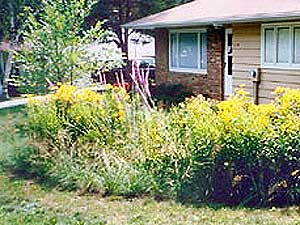|
Audio
Photos
More from MPR
Resources
Your Voice
|
Rain gardens seen as key to cutting pollution
June 23, 2004
A good Midwestern summer storm can dump a lot of water in one place. Sometimes there's so much rainwater, it floods into sewer lines, and washes untreated sewage into lakes and rivers. Cities across the country are spending millions of dollars to solve the problem. In Superior, Wisconsin, the city is encouraging people to build rain gardens. The perennial gardens are designed to hold rainwater and let it seep gradually into the ground.
Superior, Wis. — The sewage treatment plant for the city of Superior sits right on the waterfront. There are treatment tanks and pump houses. And lately there are gardens. They're demonstration plots, showing how homeowners can help solve a serious problem. Each garden is like a shallow bowl, about six inches lower than the surrounding ground. The buildings next to the gardens have downspouts that carry water from the roofs right into the gardens.
Charlene Johnson is creating these rain gardens. She dug away the surface soil, added compost, and then planted native grasses and perennials.
 | |||
"We've got the golden alexander starting to bloom," she says, pointing to the flowers. "This garden has purple coneflower, green-headed coneflower, cardinal flower, and boneset."
They're all plants that can live with a lot of water, or just a little. Johnson says they do a much better job of holding onto rainwater than a regular lawn, because they have deep roots.
"The average lawn is about one to two inches," she says. "Therefore you'd only have one or two inches of roots. Roots equal storage capacity. Also as the roots penetrate through the ground, they die back, and those holes can also be used for storm water retention."
Johnson would like it if every yard in Superior had a rain garden. The ideal size depends on the size of the house and the type of soil in the yard. But typically they're about the size of a small patio.
Lots of people are building water gardens these days -- small pools or ponds -- but a rain garden is different. It's not designed to hold water or goldfish; it's designed to absorb big rains and let them sink slowly into the ground.
"Plants and soil naturally cleanse pollutants from water. By the time it recharges into the groundwater aquifers, the water is essentially clean," Johnson says.
 | |||
And it's cheaper in the long run than sending it through a treatment plant. Johnson says rain gardens cost about the same to build as any other perennial garden - between $3 and $5 per square foot. Most of that is to buy plants.
This is an expense for homeowners. But Johnson says it will pay off in the long run, because it'll keep rainwater out of the sewage treatment system. And that could offset likely increases in monthly water bills.
On the other side of town, Jan Murphy loves her rain garden. She built it seven years ago when she built J.W. Beecroft, a bookstore and coffee shop in Superior. As the traffic speeds by on the highway, a redwing blackbird sings from the garden.
"We've had ducks," Murphy says. "It's been very delightful. We've had lots of little critters in here from time to time."
Runoff from the parking lot flows into the garden, where the cattails and other native plants clean it up before it seeps into the city storm water system. Rain gardens aren't going to solve every city's problems with storm water runoff. But they can help.
Kurt Soderberg, who directs the Western Lake Superior Sanitary District in Duluth, says rainwater picks up all kinds of pollution as it flows across parking lots, streets, and yards, and eventually into lakes and rivers.
"Rainwater is a big impact on water quality," Soderberg says. "Whether it's sediment washing into the lake, or fecal coliform going into the creeks and the lakes, there are a whole lot of reasons why you want to stop storm water from rushing into the natural bodies of water."
In Duluth, every time it rains hard, the storm water mixes with sewage and gushes into Lake Superior. The city and the sanitary district are planning to spend as much as $30 million to fix the problem. Soderberg says rain gardens could be part of the solution.
|
News Headlines
|
Related Subjects
|

